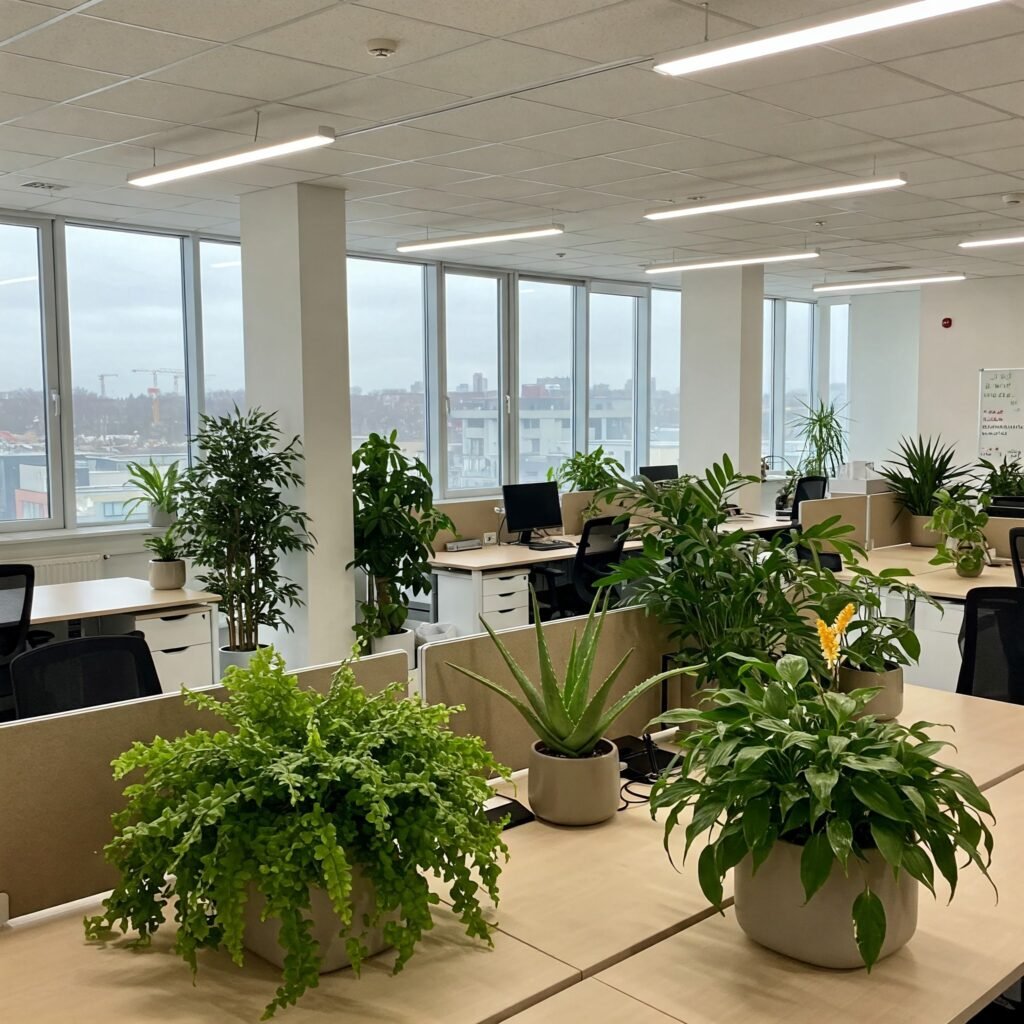Bringing nature into your office isn’t just about aesthetics—it’s a game-changer for productivity, air quality, and overall well-being. Office plants have become essential elements in modern workplaces, and for good reason. In this comprehensive guide, we’ll explore the top 15 office plants, their benefits, care tips, and creative ways to incorporate them into your workspace.
Why Office Plants Matter More Than You Think
1. They Dramatically Improve Indoor Air Quality
Many common office materials like carpets, printers, and furniture release volatile organic compounds (VOCs). Fortunately, certain office plants act as natural air purifiers. NASA’s Clean Air Study found that plants like the peace lily and snake plant effectively remove toxins like benzene and formaldehyde.
2. They Reduce Stress and Enhance Mental Well-Being
A study from the University of Hyogo in Japan revealed that employees with office plants reported lower stress levels. The simple presence of greenery can create a calming environment, reducing anxiety and improving mood.
3. They Boost Productivity and Creativity
Research from the University of Exeter showed a 15% increase in productivity when offices incorporated plants. Natural elements help maintain focus and stimulate creative thinking, making them perfect for brainstorming areas.
4. They Help with Noise Reduction
Plants absorb and diffract sound waves, which is especially helpful in open-plan offices. Large-leaf varieties like the rubber plant can reduce background noise, creating a quieter, more focused workspace.
5. They Increase Humidity and Reduce Dry Air
Air conditioning and heating systems often dry out office air, leading to irritated skin and respiratory issues. Plants like ferns and palms release moisture, naturally balancing humidity levels.

15 Best Office Plants for Every Workspace
1. Snake Plant (Sansevieria Trifasciata)
The snake plant is nearly indestructible, thriving in low light and requiring minimal watering. It also filters out formaldehyde and releases oxygen at night, making it ideal for offices.
2. ZZ Plant (Zamioculcas Zamiifolia)
This hardy plant tolerates neglect, low light, and irregular watering. Its glossy, dark green leaves add a sleek, modern touch to any desk or shelf.
3. Pothos (Epipremnum Aureum)
Pothos is one of the easiest trailing plants to grow. It removes indoor pollutants and looks great in hanging baskets or cascading from shelves.
4. Peace Lily (Spathiphyllum)
Known for its elegant white blooms, the peace lily excels at removing toxins like ammonia and benzene. It prefers shade and consistently moist soil.
5. Spider Plant (Chlorophytum Comosum)
This resilient plant is perfect for beginners. It removes carbon monoxide and thrives in indirect sunlight. Plus, it produces “spiderettes” that can be replanted.
6. Rubber Plant (Ficus Elastica)
With its large, glossy leaves, the rubber plant makes a bold statement. It prefers bright, indirect light and occasional watering.
7. Aloe Vera
Aloe vera is both decorative and practical. It thrives in sunlight, requires little maintenance, and its gel can soothe minor burns and cuts.
8. English Ivy (Hedera Helix)
This trailing vine is excellent for removing airborne mold. It grows well in hanging pots and prefers cooler temperatures.
9. Fiddle Leaf Fig (Ficus Lyrata)
A favorite in modern offices, the fiddle leaf fig needs bright, indirect light. Its large, violin-shaped leaves create a dramatic focal point.
10. Succulents (Echeveria, Haworthia, etc.)
Succulents store water in their leaves, making them perfect for forgetful waterers. They thrive in sunny spots and come in various shapes and colors.
11. Chinese Evergreen (Aglaonema)
This low-light champion removes toxins like benzene and formaldehyde. Its variegated leaves add a pop of color to dull office corners.
12. Boston Fern (Nephrolepis Exaltata)
Boston ferns are natural humidifiers, making them great for dry offices. They prefer indirect light and consistently moist soil.
13. Parlor Palm (Chamaedorea Elegans)
This compact palm thrives in low light and helps purify the air. Its feathery fronds bring a tropical vibe to any workspace.
14. Monstera Deliciosa
With its iconic split leaves, the monstera adds a jungle-like aesthetic. It prefers bright, indirect light and moderate watering.
15. Lucky Bamboo (Dracaena Sanderiana)
Lucky bamboo is low-maintenance and grows well in water or soil. It symbolizes good fortune and fits perfectly on desks or shelves.
How to Care for Office Plants: A Simple Guide
1. Choose the Right Plant for Your Office Lighting
- Low light: Snake plant, ZZ plant, pothos
- Medium light: Peace lily, spider plant
- Bright light: Fiddle leaf fig, succulents
2. Water Properly (Avoid Overwatering!)
Most office plants prefer drying out slightly between waterings. Stick your finger in the soil—if the top inch is dry, it’s time to water.
3. Maintain Proper Humidity
If your office air is dry, group plants together or place them near a humidifier. Misting occasionally also helps.
4. Dust the Leaves Regularly
Dust blocks sunlight absorption. Wipe leaves gently with a damp cloth to keep them healthy.
5. Fertilize Occasionally
Use a balanced liquid fertilizer every 2-3 months during the growing season (spring and summer).
Where to Place Office Plants for Maximum Impact
- Desks: Small plants like succulents, lucky bamboo, or aloe vera
- Shelves & Cabinets: Trailing plants like pothos or spider plants
- Corners & Empty Spaces: Tall plants like fiddle leaf figs or rubber plants
- Meeting Rooms & Reception Areas: Statement plants like monstera or peace lilies
Common Mistakes to Avoid with Office Plants
- Overwatering: This is the #1 killer of office plants. Always check soil moisture first.
- Ignoring Light Requirements: Not all plants survive in windowless offices. Choose wisely.
- Using Pots Without Drainage: Excess water needs an escape route to prevent root rot.
- Neglecting Pest Control: Check occasionally for spider mites or mealybugs.
Creative Ways to Display Office Plants
- Hanging Planters: Save desk space with suspended pothos or ivy.
- Terrariums: Mini glass gardens add a stylish touch.
- Wall-Mounted Planters: Vertical gardens maximize greenery in small offices.
- Desktop Planters: Small pots with succulents or air plants personalize workspaces.
Final Thoughts: Why Every Office Needs Plants
Office plants do more than just look pretty—they create healthier, happier, and more productive workspaces. Whether you opt for a low-maintenance snake plant or a statement-making monstera, adding greenery is a simple yet powerful way to enhance your office environment.
Start small with one or two plants, and gradually expand as you see the benefits. Your employees (and your lungs) will thank you!
